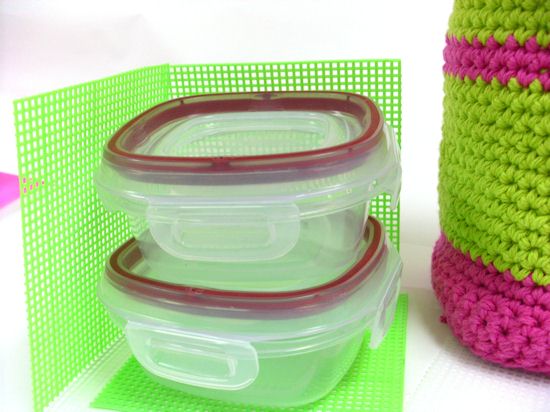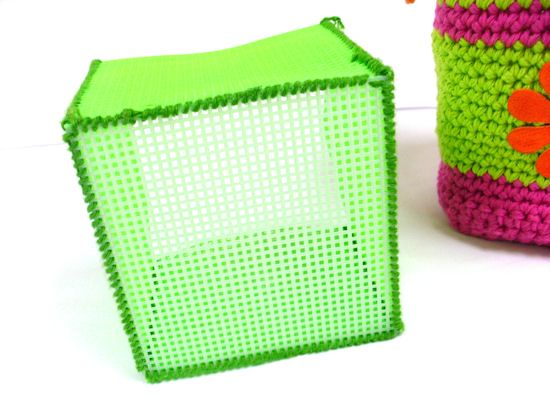|
Sizes and Materials List …
|
| Size: |
Tote measures 7″ tall x 6″ square. Model was customized to fit a specific food container, which is listed at the beginning of the pattern. Directions for customizing your own container are given at the end of this pattern. |
| Hook(s): |
US K/10.5 (6.5 mm) (or sized needed to make gauge)
US G/6 (4.0 mm) (or sized needed t make gauge)
|
| Yarn: |
Lily Yarn Company, Sugar ‘n Cream [100% cotton,120 yds/70.9 g ball] |
Colors &
Approx. Yardage |
(A) #01740 Hot Pink, 120 yards (1 ball)
(B) #01712 Hot Green, 240 yards (2 balls)
(C) #01628 Hot Orange, 60 yds (1 ball) |
| Notions |
2 Rubbermaid 1.25 cup food containers (approximately 5″ square x 2/25″ tall)
Yarn needle
Scissors
Ruler
3 1″ diameter macramé or other rings
Iron-on flower appliqué (optional)
Plastic canvas (optional) |
| Gauge: |
11 sts and 14 rows = 4”/10 cm in sc with larger hook and yarn held doubled
Always take time to check your gauge
|
|
   |
|
Notes …
|
| Working |
- Pattern is stitched with yarn held doubled throughout, unless otherwise indicated.
- Tote is worked continuously from the bottom (gusset) upwards.
- Bottom is worked in rows while sides are worked in joined rounds.
- Covering the rings is optional; rings can be left as is.
|
| Stitches Used |
Chain (ch)
Slip Stitch (sl st)
Single Crochet (sc)
Half-Double Crochet (hdc)
Double Treble Crochet (dtr) |
| Abbreviations |
Each (ea)
Stitch(es) (st / sts)
|
|
Instructions …
|
| Bottom (Gusset) |
| Base Chain |
With larger hook and two strands of A, loosely ch 15. |
| Row 1 |
Working in back loops, sc in 2nd ch from hook and in each ch across. (14 sts) |
| Rows 2-16 |
Ch 1, turn, sc in ea sc across. Do not fasten off. (14 sts) |
| Sides |
| Round 1 |
Ch 1, *sl st into ea of the 14 sts, rotate left and sl st across row ends for 13 sts* repeat from * to * once, join with sl st to ch 1. (54 sts) |
| Round 2 |
Ch 1, working in back loops only, sc in ea sc around, joining to ch 1 with sl st |
| Rounds 3-4 |
Ch 1, sc in ea sc around, joining to ch 1 with sl st at end of ea round and changing to B at end of round 4. Fasten off A. |
| Rounds 5-15 |
Ch 1, sc in ea sc around, joining to ch 1 with sl st at end of ea round and changing to A at end of round 15. Fasten off B. |
| Rounds 16-18 |
Ch 1, sc in ea sc around, joining to ch 1 with sl st at the end of ea round and changing to B at end of round 18. Fasten off A. |
| Rounds 19-23 |
Ch 1, sc in ea sc around, joining to ch 1 with sl st at end of ea round. Fasten off B at end of round 23. |
| Round 24 |
Attach C, ch 1 and sc in ea sc around, joining to ch 1 with sl st at end of round. Fasten off. |
|
Finishing …
|
|
Weave in ends.
|
| Handle (make 1) |
| Base Chain |
With a single strand of A and smaller hook, ch 31. |
| Row 1 |
Working in back loops, sc in 2nd ch from hook and in ea ch across changing to C at last st. Fasten off A. (30 sts). |
| Rows 2-3 |
Ch 1, turn, sc in each sc across. Fasten off, leaving long tail for sewing. |
| Rings (make 3) |
|
With C and smaller hook, sc tightly around ring, making certain to push sts tightly against one another to prevent ring showing through. Repeat for all rings. Leave long tail for attaching to tote.

|
| Finishing … |
| Using yarn needle and long tails, attach rings as follows: Working along the top of the tote, locate the middle of each of the four sides and mark each with a pin. Sew the three rings on each of three sides and attach the handle, folded in half, to the fourth side.
|
| Iron on flower appliqué as directed on package. |
| Complete optional plastic canvas insert, as desired. See the Customizing Your Own Bento Caddy Tutorial for instructions on the plastic canvas insert and measuring your own containers for a custom caddy. |
|
Close tote by threading handle through the rings.

|
|
Shop at discount and dollar stores for accessories such as plastic utensils, small, colorful plates, food picks, cookie cutters for cutting out food (cheese, meat, and sandwich shapes), etc. Use your imagination and have fun. Bento lunch accessories don’t have to be expensive. Be sure to check for after holiday sales on colorful items such as paper napkins, plates, and so on.

|
| Plastic Canvas Insert (optional) |
|
These plastic canvas inserts are designed to act as support for your caddy. They allow the tote to hold it’s shape under the weight of the food containers, for a neater, more finished appearance. However, because the caddy’s are made with worsted weight yarn, held doubled & crocheted tightly, they are relatively stiff. The decision to make a complete box insert or just an insert for the bottom is a personal design decision.
The complete box insert is made in five pieces and stitched together using simple hand basting technique.
|
| Materials |
Plastic canvas sheets (available at the large chain stores)
Cardboard for making pattern
Scissors
Ruler
Small amount acrylic yarn for stitching insert together
Yarn Needle |
| Step 1 |
Begin by measuring & cutting out the bottom gusset. Using the dimensions of your caddy (see instructions further down for customizing your caddy), subtract approximately 1/2″ from the length and width (insert should be slightly smaller than tote for proper fit). Record these numbers and mark them out on a piece of cardboard and carefully cut the pieces out. Insert into tote for fit, trim as needed. Use cardboard cut-out as a pattern and mark cutting lines on the plastic canvas. Carefully cut the piece out, trimming the edges for a smooth finish. |
| Step 2 |
Using the gusset piece as a measuring guide, mark the width of the side piece. Determine the height by placing the plastic container(s) on a flat surface and measuring from the bottom to top. The insert should be level with the top of the container. Repeat three more times, making certain to adjust two of the sides if tote is rectangular rather than square.
|
| Step 3 |
Using acrylic yarn, begin sewing insert together as follows:
- Attach all side pieces to gusset. Match 1 side piece to gusset piece, making certain holes in the canvas are evenly matched.
- Insert yarn into hole in gusset and corresponding hole in side piece. Pull yarn through tightly.

- Repeat #2 above, inserting yarn into the next set of holes and so forth, until side is sewn.
- Repeat for all side pieces.
- Tie knot and run yarn through a few stitches to anchor.
- Stitch sides together using the same technique.

|
| Customizing Your Caddy Tutorial |
| Materials |
Plastic food container of choice
Paper & pencil
Tape measure |
| Step 1 |
Find a plastic container that is suitable for your needs. Keep the box with your crochet project at all times during the crocheting process, so that you can check for fit as you work. Sketch out your box as indicated below.
|
| Step 2 |
The pattern starts with the bottom gusset. Most plastic food containers are flanged towards the top, making the top dimension obviously larger than those of the bottom. Keeping this in mind, measure the box across the top, with the lid on.
|
| Step 3 |
Now you have your starting dimensions. If the piece measured 8 inches x 6 inches, you’d need to add at least 2 extra rows and 4 sts (to equal ½ to 1 inch wider and longer than actual dimensions), so the caddy will have some ease and not fit too tightly.
The pattern is worked with worsted weight yarn, holding two strands together for the bottom and sides. Given the measurements of your container, crochet a test swatch to determine how many sts and rows are needed to equal the dimension, in this example, 9″ x 7″ (This includes the added inch to accommodate ease).
To determine the height of the tote, measure the height of the container. Add at least 4 to 6 inches of height to tote. See schematic below (tote is depicted in green);.
|
| Step 4 |
Start to Crochet: |
| Gusset |
| Base Chain |
With larger hook and yarn held doubled, make a beginning chain based on your swatch findings. |
| Row 1 |
Working in back loops, sc in second ch from hook and in ea ch across. |
| Row 2 to end |
Ch 1, turn, sc in ea sc across. Check against the bottom of the container, for fit. Remember it should be about 1″ longer and wider than the box. Continue crocheting rows until the piece is about 1″ wider than the container. Do not fasten off. |
| Once the proper size has been made, proceed with the sides, working in joined rounds. Check progress against the container itself. Don’t forget to write down the number of sts, rows, and the height dimension in case you want to make more. |
| Sides |
| Round 1 |
With larger hook and yarn held doubled, ch 1 and sl st around entire piece, working evenly across row ends on both sides. |
| Round 2 |
Working in the back loops only, sc around, joining last st to ch 1 with sl st. (Number of sts depends upon your individualized pattern based upon dimensions as above.) |
| Round 3 to end |
Sc in joined rounds, finish off at last rnd, weaving and trimming the ends. |
| Handle & Rings |
Complete following instructions above. |
| Pattern and photos © Nancy Anderson |